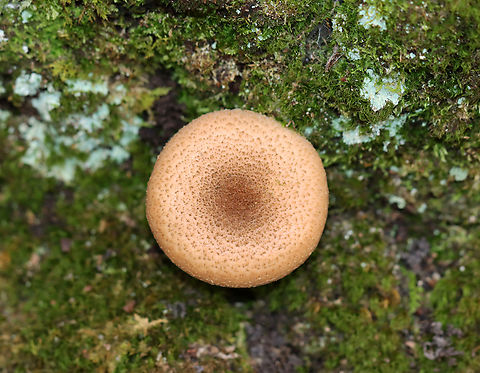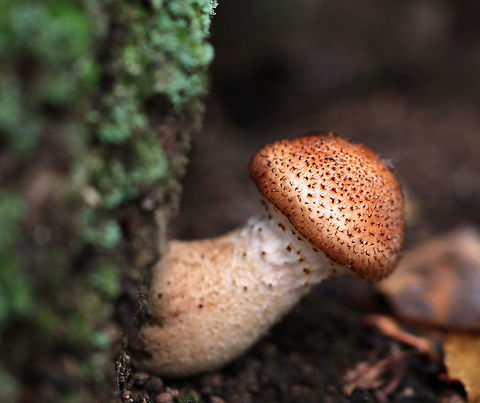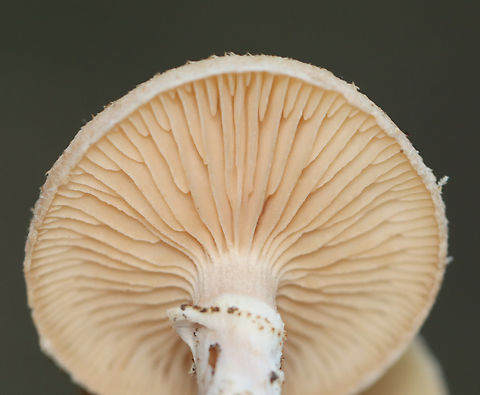
Appearance
The fruit bodies of "Armillaria gallica" have caps that are 2.5–9.5 cm broad, and depending on their age, may range in shape from conical to convex to flattened. The caps are brownish-yellow to brown when moist, often with a darker-colored center; the color tends to fade upon drying. The cap surface is covered with slender fibers that are erect, or sloping upwards.When the fruit bodies are young, the underside of the caps have a cottony layer of tissue stretching from the edge of the cap to the stem—a partial veil—which serves to protect the developing gills. As the cap grows in size the membrane is eventually pulled away from the cap to expose the gills. The gills have an adnate to somewhat decurrent attachment to the stem. They are initially white, but age to a creamy or pale orange covered with rust-colored spots. The stem is 4–10 cm long and 0.6–1.8 cm thick, and almost club-shaped with the base up to 1.3–2.7 cm thick. Above the level of the ring, the stem is pale orange to brown, while below it is whitish or pale pink, becoming grayish-brown at the base. The ring is positioned about 0.4–0.9 cm below the level of the cap, and may be covered with yellowish to pale-brownish woolly cottony mycelia. The base of the stem is attached to rhizomorphs, black root-like structures 1–3 mm in diameter. While the primary function of the below-ground mycelia is to absorb nutrients from the soil, the rhizomorphs serve a more exploratory function, to locate new food bases.

Distribution
"Armillaria gallica" can normally be found on the ground, but sometimes on stumps and logs. Mushrooms that appear to be terrestrial are attached to plant roots underneath the surface. It is widely distributed and has been collected in North America, Europe, and Asia. The species has also been found in the Western Cape Province of South Africa, where it is thought to have been introduced from potted plants imported from Europe during the early colonization of Cape Town. In Scandinavia, it is absent in areas with very cold climates, like Finland or Norway, but it is found in southern Sweden. It is thought to be the most prevalent low altitude species of "Armillaria" in Great Britain and France. The upper limits of its altitude vary by region. In the French Massif Central, it is found up to 1,100 m, while in Bavaria, which has a more continental climate, the upper limit of distribution reaches 600 m. In Serbian forests, it is the most common "Armillaria" between elevations of 70 to 1,450 m. Field studies suggest that "A. gallica" prefers sites that are low in organic matter and have high soil pHs.In North America, it is common east of the Rocky Mountains, but rare in the Pacific Northwest. In California, where it is widely distributed, the fungus is found in a variety of plant communities, including aspen, coastal oak woodland, Douglas Fir, Klamath mixed conifer, montane hardwood, montane hardwood-conifer, montane riparian, Redwood, Sierran mixed conifer, valley oak woodland, valley-foothill riparian, and White Fir. It was found to be the most common "Armillaria" species in hardwood and mixed oak forests in western Massachusetts.

Behavior
The life cycle of "A. gallica" includes two diploidization–haploidization events. The first of these is the usual process of cell fusion followed by meiosis during the formation of haploid basidiospores. The second event is more cryptic and occurs before fruit body formation. In most basidiomycetous fungi, the hyphae of compatible mating types will fuse to form a two-nucleate, or dikaryotic stage; this stage is not observed in "Armillaria" species, which have cells that are mostly monokaryotic and diploid. Genetic analyses suggest that the dikaryotic mycelia undergo an extra haploidization event prior to fruit body formation to create a genetic mosaic. These regular and repeating haploidization events result in increased genetic diversity, which helps the fungus to adapt to unfavorable changes in environmental conditions, such as drought.The growth rate of "A. gallica" rhizomorphs is between 0.3 and 0.6 m per year. Population genetic studies of the fungus conducted in the 1990s demonstrated that genetic individuals grow mitotically from a single point of origin to eventually occupy territories that may include many adjacent root systems over large areas of forest floor. Based on the low mutation rates observed in large, long-lived individuals, "A. gallica" appears to have an especially stable genome. It has also been hypothesized that genetic stability may result from self-renewing mycelial repositories of nuclei with stem cell-like properties.
References:
Some text fragments are auto parsed from Wikipedia.